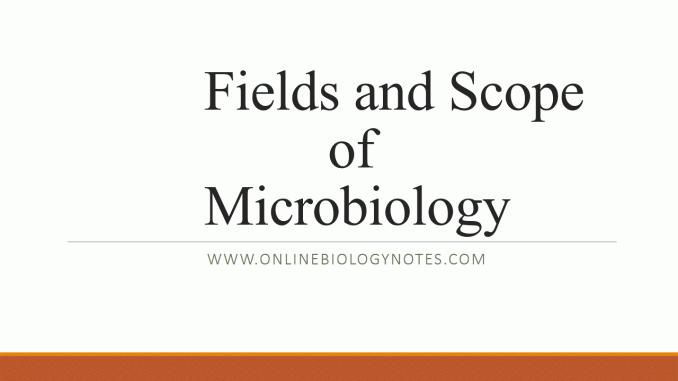
Fields and scope of microbiology
Fields or branches:
Microbiology has two major fields
- Pure Microbiology
- Applied Microbiology
1. Pure microbiology:
i. on the basis of Taxonomical classification
- Bacteriology
- Mycology
- Phycology
- Virology
- Protozoology
- Immunology
ii. on the basis of Integrative characteristics
- Microbial cytology
- Microbial physiology
- Microbial genetics
- Microbial ecology
- Microbial taxonomy
- Cellular Microbiology
- Molecular Microbiology
2. Applied Microbiology:
on the basis of application
- Medical Microbiology
- Veterinary Microbiology
- Public Health Microbiology
- Industrial Microbiology
- Pharmaceutical Microbiology
- Agriculture Microbiology
¤ Plant Microbiology
¤ Soil Microbiology - Food and Dairy Microbiology
- Environmental Microbiology
- Water/Aquatic Microbiology
- Aero-microbiology
- Microbial Biotechnology
- Vaccinology
- Chemotherapy
Scope of microbiology
1. Ecology and environment:
- Bacteria are primary decomposers – recycle nutrients back into the environment (sewage treatment plants)
- Winogradsky and M. Beijerinck studied soil microbes and their role in the biochemical cycles of sulfur, carbon, nitrogen etc.
- Insect Pest Control: some bacteria are used as bio-pesticides to control Insects pest. Eg. Bacillus thuringiensis
- Bioremediation: microbes are also used to clean up pollutants and toxic wastes. Eg. Pseudomonas putida; used to remove petroleum spill.
2. Food microbiology:
- Microbes are used in various food and dairy industries to produce various food products
- cheese, pickles, sauerkraut, green olives
- yogurt, soy sauce, vinegar, bread
- Beer, Wine, Alcohol
- Pasteur (1856) describe fermentation technology
3. Medicine: clinical and pharmaceutical microbiology
- Disease Treatment: Microbes are used to produce Antibiotics
- Eg. Penicillium notatum (Penicillin); discovered by Alexander Fleming (1928)
- Bacteria also synthesize vitamins which is needed for our body.
- Example: E. coli
- Vitamin-B; needed for metabolism
- Vitamin-K; needed for blood clotting
- Gene therapy for treatment of genetic dsiseases
4. Vaccine and immunology:
- Vaccine activates immune response.
- Edward Jenner inoculated people with cowpox to protect against smallpox.
- Pasteur developed the rabies vaccine (1885).
- Von Behring and Kitasato (1890) produced toxoid vaccine against diphtheria and tetanus.
- Metchnikoff (1884) described role of phagocytic cell in defense.
5. Genetic engineering:
- Microorganisms are used in Recombinant DNA Technology or Genetic Engineering to manipulate their gene for the production of useful products such as enzymes, hormones, interferons, etc
- Microorganisms are used as model organism in molecular biology.
6. Biochemistry and physiology:
- Microorganisms are used as a model for study of many biochemical and physiological processes.
7. Industrial microbiology:
- Microbes are used in economic and industrial purposes.
- Biotechnology, fermentation technology, food and beverages etc are now established on large industrial scale for income.
- Patients right of procedure
8. Agriculture microbiology:
- Genetic engineering is used for the production of transgenic plants and animals.
- Animal and plant improvement by biotechnology for better production, resistant to environmental fluctuation.
- Molecular farming: transgenic animal or plant are used as bioreactor for mass production
9. Geochemical microbiology;
- Bioleaching: recovery of minerals from low grade ores
- Role of microorganism in geochemical cycle
10. Exomicrobiology:
- Exploring for life in outer space
